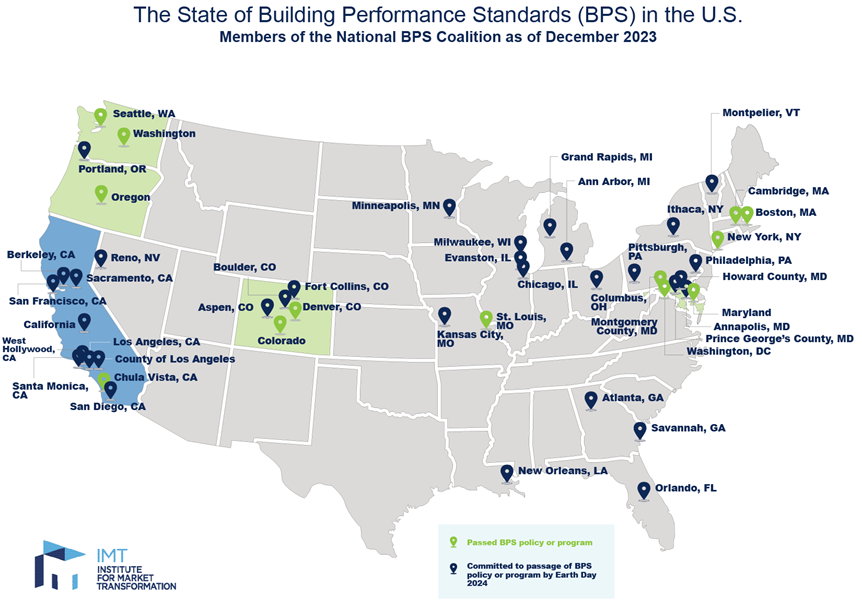By: Christina Rogelio, LEED AP BD+C
Building Performance Standards (BPS)
BPS policies are a set of standards that state and local governments use to achieve minimum levels of energy or climate performance. BPS complement building energy codes and are used as a tool to drive improved performance in new and existing buildings. Additional benefits vary depending on each local government, but can include local job creation, economic growth, reduced energy costs, increased renewable energy use and electrification, indoor air quality metrics and requirements for under-performing buildings, increased building resilience to climate threats, and others. [1]
The success of BPS is dependent on equitable and effective policy implementation and meeting building performance targets by specific deadlines set by each jurisdiction. Those that directly affect, influence, and implement BPS policies include building owners, architects and engineers, property managers, general contractors, sustainability specialists, and others. Building owners can request improved HVAC systems to lower energy bills and provide healthier air, while general contractors can provide new job opportunities to guide and implement BPS-designed buildings.
Non-Compliance Penalties in MD vs. Higher Return on Investments
As a result of BPS policies required by local governments, there are also penalties for non-compliance. While BPS set a standard for energy efficient and sustainable practices to be installed in buildings, BPS also issue warnings or penalties in the form of fines or compliance fees. For Maryland, covered buildings must meet interim standards in 2030 through 2039 and final standards in 2040 and beyond or pay an alternative compliance fee or penalty. [2] BPS also provide accountability through public disclosure, where some jurisdictions will publicly disclose non-compliant buildings. Moreover, BPS incentivize building owners by retaining tenants and meeting stakeholders’ needs to demonstrate company commitment to sustainability and demonstrate progress concerned with climate change.
Where are BPS Policies Implemented?
The adoption of BPS policies at the national, state, and local level reflects the commitment to address climate change and highlight sustainable practices on a broader scale. As of December 2023, five states have passed or are committed to passing a BPS policy by Earth Day 2024, shown in the graphic below. In July 2023, Maryland joined the White House National Building Performance Standards Coalition [3] and has developed a BPS that is awaiting implementation. [4] In and around Maryland, localities have passed or will pass a BPS policy including Howard County, Montgomery County, Prince Georges County, and Annapolis, as well as Washington DC, Philadelphia, PA, and others. Statewide adoption ensures that compliance and community benefits include all communities and are not just limited to cities.
A BPS policy can also serve as a vehicle to regulate building performance beyond energy consumption and carbon emissions into areas such as public health, housing affordability, and resilience – complex social and environmental problems all related to the built environment. Sustainable design advantages include cost savings, environmental benefits, improved health and well-being through energy efficiency, reduced carbon footprint, and the potential of certification recognition by a green building performance rating system.
Straughan’s services in sustainable design and green building projects includes leadership and active engagement through implementation of best practices and credibility through relationships with other professionals, including architects, builders, and potential clients within sustainability and the green building community.

Per the Maryland Department of the Environment (MDE), Maryland’s statewide BEPS policy for buildings 35,000 SF or larger awaits implementation:
“The goal is to reduce direct greenhouse gas (GHG) emissions and improve overall energy efficiency from Maryland’s building sector for certain buildings that are 35,000 square feet or larger. The regulation requires covered building owners to measure and report data to the Maryland Department of the Environment (MDE). The regulation further requires that covered building owners meet specific net direct GHG emissions and energy use intensity (EUI) standards. This dual- standard system promotes efficient electrification to enable Maryland’s clean energy transition, minimize electricity grid impacts, and achieve Maryland’s goal of net-zero GHG emissions by 2045. The regulation also contains record keeping and reporting requirements for electric and gas companies and district energy providers.” [5]
[1] https://imt.org/public-policy/building-performance-standards/
[2] https://mde.maryland.gov/programs/air/ClimateChange/Pages/BEPS.aspx
[3] https://nationalbpscoalition.org/#about
[4] Maryland BEPS Fact Sheet.pdf
[5] https://mde.maryland.gov/programs/air/ClimateChange/Pages/BEPS.aspx
